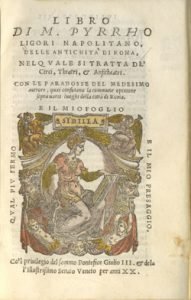Tensions in Renaissance Cities
Exhibition dates: March 27 – June 9, 2017
Location: Special Collections Research Center Exhibition Gallery, 1100 East 57th Street, Chicago, IL 60637
Venice, Florence, Rome, Mexico City, Geneva, London: the rapidly transforming cities of the Renaissance used art and literature to express their growing power, and growing pains. In the centuries of recovery after the Black Death, wealth, trade, and technology accelerated exponentially. Urban centers existed in a web of interdependence, in which the borders of fluctuating kingdoms were overlaid by geographies of mercantile connections, and information networks whose influence exploded with the arrival of the printing press. This new invention let news of new discoveries or disasters sweep through Europe in weeks, rather than years.
Moving geographically, this exhibit charts the interconnected tensions of great capitals from Venice to Mexico City. As Venice looked both eastward towards Islamic cultures of the Mediterranean and inward toward the microcosmic tensions of diversifying populations, Mexico City grappled with cultural and religious clashes between native Mesoamerican and imported European traditions. Florence and Rome looked backward toward the golden dream of antiquity and upward into a celestial geography. Magic, science, humanism and theology each played a role in filling in the blanks in current knowledge of the world and the universe. Concurrently, Geneva saw conflict in shifts from Latin to the vernacular and changing Calvinist and Catholic devotional practices, and London sought to establish itself as a major intellectual center that was both in dialogue with and distinct from continental centers.
The treasures presented in this exhibit from the Special Collections Research Center and Smart Museum of Art at the University of Chicago offer a look into the Renaissance not as a single, coherent cultural movement, but rather a set of many simultaneous and often contradictory developments across scholarship, politics, and religion. Many of the cultural, political, and religious tensions experienced during this period are just as relevant today. In an effort to create a neat narrative, the history of a period can be cleaned up too much. By examining the nuances and complexities of the early modern past, this exhibition hopes to shed light on just how messy history can be in both the past and the present.
Curators: Ada Palmer, Assistant Professor, Department of History and the College, The University of Chicago; Hilary Barker, PhD student, Department of Art History, The University of Chicago; Margo Weitzman, MAPH’15, The University of Chicago
Hours: Mondays through Fridays, 9 a.m. – 4:45 p.m., and, when University of Chicago classes are in session, Tuesdays and Wednesdays, 9 a.m. – 5:45 p.m.
Related Events
Curator’s Open House for the Renaissance Society of America Conference
March 29, 2017, 12 noon – 5 p.m.
Special Collections Research Center, Regenstein Library, 1100 East 57th Street, Chicago
Curators Ada Palmer, Hilary Barker, and Margo Weitzman will be on hand to discuss and give tours of the exhibition Tensions in Renaissance Cities.
Free and open to the public. Those attending the Renaissance Society of America Conference can sign up for transportation on the conference events page.
Library Society Lecture and Exhibition Viewing
May 10, 2017 – 5 p.m.
Special Collections Research Center Exhibition Gallery and Room 122, Regenstein Library, 1100 East 57th Street, Chicago
Lecture by Ada Palmer, Assistant Professor, Department of History and the College, The University of Chicago
Use of Images and Media Contact
Images from the exhibition included on this page are available for download by members of the media and are reserved for editorial use in connection with University of Chicago Library exhibitions, programs, or related news.







